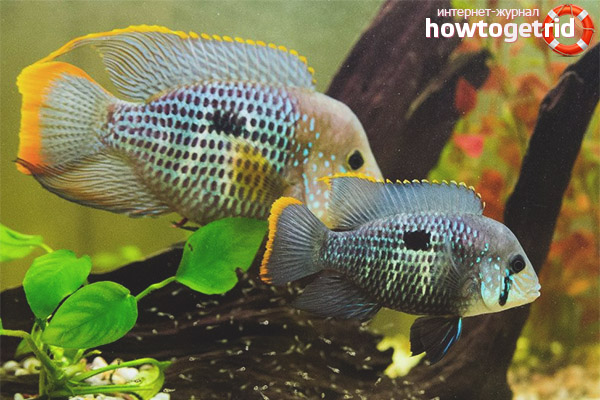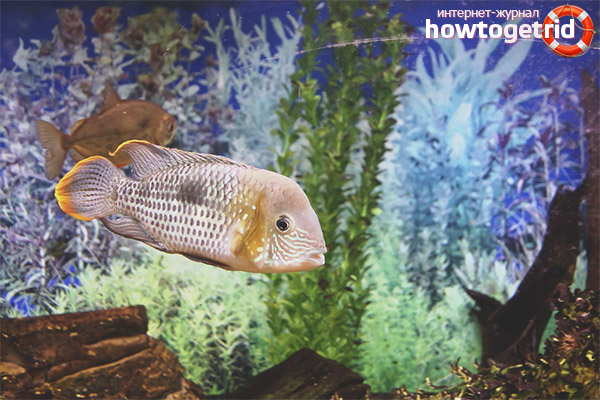The content of the article
The Latin name for the turquoise species of acar is Andinoacara rivulatus. The fish has a very bright color, the whole body is covered with scales that shine with a bright shade of blue. But these fish are interesting not only in such a pronounced color, but also in unusual behavior. What else is the feature of Akara?
Previously, turquoise and bluish-spotted Akara belonged to the same species. But today, each species is considered as a separate species. Not everyone knows about this, so they are often confused. The separation is due to the fact that, despite the similarity, each of these varieties has its own individual characteristics that distinguish them from each other.
Turquoise Akara usually has a larger size compared with bluish-spotted. In nature, a fish of this species can grow up to 25-30 cm. The second variety usually reaches about 20 cm. Another difference from one species to another is that turquoise male males, having reached puberty, have a pronounced cone on their heads, consisting of adipose tissue. In males of the second species, this cone is also present, but has a smaller size.
In addition, a distinctive feature of turquoise turkey is a large degree of aggressiveness. In many English-speaking countries, this fish is called Green Terror, which can be translated as "green horror."
This species can be attributed to quite unpretentious. Therefore, taking care of the fish is quite simple. But it is better to start it for those who have the basic skills for caring for the aquarium. Akara needs the water in it to always be fresh and of high quality, as well as the feed it feeds on.
If you decide to purchase such a fish, it is important to remember that it, like many other large cichlids, needs a large aquarium. At an early age, the fish may well coexist in the neighborhood with others, but the older they get, the more aggressive they are. They are best kept with the same large and aggressive representatives.
Living in nature
The food for turquoise turquoise are insects, larvae. In addition, they can feed on small fish and some invertebrates.
Description
Representatives of this species have a rather strong body. Their back and anal fins have a pointed shape. And the caudal fin is rounded. Turquoise Akara can be attributed to large fish. As already noted, in the wild, it can grow up to 30 cm. With an aquarium content, representatives of the species grow up to about 15-20 cm
On average, a cancer can live about 7-10 years. In this case, the conditions of detention must be observed. Sometimes a fish can live longer. This is proved by some data.
Content Issues
This fish have a very bright and beautiful appearance, which attracts many aquarists. Everyone will want to have such an instance in their aquarium. But before you get a representative of this species, you need to know some of the nuances associated with the content of the cancer. In addition, a person must have some experience. Beginners are not recommended to buy such a fish. Another difficulty is that the turquoise Akar has a relatively large size for aquarium fish.In addition, she tends to be aggressive. Therefore, for its maintenance a large aquarium is needed. If several cancers and other smaller fish coexist in the same aquarium, then the cancers will constantly terrorize their neighbors and keep them at bay. Therefore, it is recommended to settle no less strong and large fish in the same aquarium with Akara.
Representatives of this species are sensitive to changing environments and water characteristics. They should be started by those who already have experience in the maintenance of large cichlids. If you do not have experience, but you still really want to get them, then before that you need to prepare suitable conditions for the cancer, as well as thoroughly study all the rules and recommendations for their content.
Feeding
It is important to remember that turquoise Akara is a predatory fish. She can eat any food, but sometimes she can be capricious. If you keep representatives of this species in the aquarium, it is advisable for them to select feeds with a high calorie content. It can be a pipe maker, crickets, worms, etc. In addition, they can eat fish fillets, as well as shrimp and mussels. Today in the pet shop you can buy food that is designed specifically for large cyclides. Such a food is perfect for akar, and will provide it with a supply of all the substances that it needs. Sometimes a variety of foods can be added to the diet by adding worms or fish.
To make the feed more beneficial to the fish, you can add plant components, for example, spirulina.
Giving feed to the acar should be twice a day. Sometimes it can be enough even once, but the portion should not exceed the amount that the fish can eat at a time.
Content
As already mentioned, turquoise acar needs to provide a sufficient amount of free space. This applies to all large cichlids that originated from the waters of South America. To ensure the normal maintenance of a pair of turquoise cancers, you must have an aquarium with a volume of at least 300 liters. If there are more fish, then, accordingly, the volume of the aquarium should be larger.
In addition, for these fish it is very important that the water parameters have indicators that are comfortable for them. The temperature should be 20-24 degrees. In addition, turquoise cancers feel good in water with a low level of hardness and a neutral pH level. It is very important that the external filter has high power. It is also necessary to ensure that there is no ammonia and nitrates in the water.
In the aquarium, a moderate level of lighting must be provided. The decor should be one that is usually suitable for cichlids. Basically, these are snags and kamki. Sand should be used as soil. At the same time, it is not recommended to use plants for decoration, since representatives of this species prefer to dig up the soil so that it meets their needs. Therefore, all planted plants usually float.
Compatibility
For turquoise cancers, the most important condition for comfort is free space. If they have it, then the level of aggression will become less. Sometimes akara herself can provoke other fish into conflict. But there are representatives with a more relaxed character.
If we talk about the attitude to the fish of their species, it is best to keep only one pair in one aquarium. Otherwise, fights cannot be avoided. During spawning, it is better to set them apart, as the level of aggression increases.
With small cichlids that are from Africa, turquoise acara will not be able to coexist. She will either kill them or keep them at bay. Therefore, it is better to settle larger fish for them. It can be: astronotus, cichlazoma, parrots and others.
Gender differences
Breeding
Representatives of this species have been bred for a long time. But this may cause some problems. Not every fish pair is able to coexist peacefully. Therefore, you need to buy some fish. They will grow up and decide on a pair themselves.
When breeding, it is necessary to maintain a water temperature of 25-26 degrees. The acidity level of water can be slightly increased. A pair of cancers cleans driftwood or stone. Fish lays about 400 eggs. After a few days, a larva appears. And after 10 days the fry will already swim in the aquarium, who will eat on their own. You need to feed them with chopped food or yolk. At first, they gain weight very slowly, but when they reach 2 cm, they begin to grow faster.
Video: aquarium fish akara turquoise












Submit